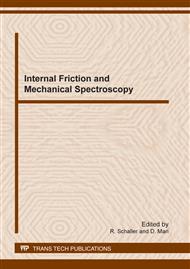[1]
L.B. Magalas, Determination of the logarithmic decrement in mechanical spectroscopy, Sol. St. Phen. 115 (2006) 7-14.
Google Scholar
[2]
L.B. Magalas, M. Majewski, Recent advances in determination of the logarithmic decrement and the resonant frequency in low-frequency mechanical spectroscopy, Sol. St. Phen. 137 (2008) 15-20.
DOI: 10.4028/www.scientific.net/ssp.137.15
Google Scholar
[3]
L.B. Magalas, T. Malinowski, Measurement techniques of the logarithmic decrement, Sol. St. Phen. 89 (2003) 247-260.
DOI: 10.4028/www.scientific.net/ssp.89.247
Google Scholar
[4]
L.B. Magalas, M. Majewski, Ghost internal friction peaks, ghost asymmetrical peak broadening and narrowing. Misunderstandings, consequences and solution, Mater. Sci. Eng. A 521-522 (2009) 384-388.
DOI: 10.1016/j.msea.2008.10.073
Google Scholar
[5]
L.B. Magalas, A. Stanisławczyk, Advanced techniques for determining high and extreme high damping: OMI – A new algorithm to compute the logarithmic decrement, Key Eng. Materials 319 (2006) 231-240.
DOI: 10.4028/www.scientific.net/kem.319.231
Google Scholar
[6]
L.B. Magalas, A. Piłat, Zero-Point Drift in resonant mechanical spectroscopy, Sol. St. Phen. 115 (2006) 285-292.
DOI: 10.4028/www.scientific.net/ssp.115.285
Google Scholar
[7]
L.B. Magalas, Mechanical spectroscopy – fundamentals, Sol. St. Phen. 89 (2003) 1-22.
Google Scholar
[8]
S. Etienne, S. Elkoun, L. David, L.B. Magalas, Mechanical spectroscopy and other relaxation spectroscopies, Sol. St. Phen. 89 (2003) 31-66.
DOI: 10.4028/www.scientific.net/ssp.89.31
Google Scholar
[9]
I. Yoshida, T. Sugai, S. Tani, M. Motegi, K. Minamida, H. Hayakawa, Automation of internal friction measurement apparatus of inverted torsion pendulum type, J. Phys. E: Sci. Instrum. 14 (1981) 1201-1206.
DOI: 10.1088/0022-3735/14/10/024
Google Scholar
[10]
D. Agrež, A frequency domain procedure for estimation of the exponentially damped sinusoids, 12 MTC: 2009 IEEE Instrumentation and Measurement Technology Conference, 1-3 (2009) 1295-1300.
DOI: 10.1109/imtc.2009.5168660
Google Scholar
[11]
K. Duda, L.B. Magalas, M. Majewski, T.P. Zieliński, DFT-based estimation of damped oscillation parameters in low-frequency mechanical spectroscopy, IEEE Transactions on Instrumentation and Measurement, 60 (2011) 3608 - 3618.
DOI: 10.1109/tim.2011.2113124
Google Scholar
[12]
L.B. Magalas, Snoek-Köster relaxation. New insights – New paradigms, J. de Phys. IV, 6 (C8) (1996) 163-172.
DOI: 10.1051/jp4:1996834
Google Scholar
[13]
E. Bonetti, E.G. Campari, L. Pasquini, L. Savini, Automated resonant mechanical analyzer, Rev. Sci. Instrum. 72 (2001) 2148-2152.
DOI: 10.1063/1.1357235
Google Scholar
[14]
J. Rubianes, L.B. Magalas, G. Fantozzi, J. San Juan, The Dislocation-Enhanced Snoek Effect (DESE) in high-purity iron doped with different amounts of carbon, J. de Phys. 48 (C-8) (1987) 185-190.
DOI: 10.1051/jphyscol:1987825
Google Scholar
[15]
L.B. Magalas, J.F. Dufresne, P. Moser, The Snoek-Köster relaxation in iron, J. de Phys. 42 (C-5) (1981) 127-132.
DOI: 10.1051/jphyscol:1981519
Google Scholar
[16]
L.B. Magalas, S. Gorczyca, The Dislocation-Enhanced Snoek Effect – DESE in iron, J. de Phys. 46 (C-10) (1985) 253-256.
DOI: 10.1051/jphyscol:19851057
Google Scholar
[17]
L.B. Magalas, P. Moser, I.G. Ritchie, The Dislocation-Enhanced Snoek Peak in Fe-C alloys, J. de Phys. 44 (C-9) 645-649. a b c d Fig. 1. Dispersion of 100 d values for 100 free decaying oscillations (d = 5×10-4, = 1. 12345 Hz, S/N= 32 dB, and = 1 kHz) computed according to: OMI, YM, YMC, YL, and Y methods for different lengths of the signal. a b c d Fig. 2. Variation of the relative error for computed d values obtained for 100 free decaying oscillations (d = 5×10-4, = 1. 12345 Hz, S/N= 32 dB, = 1 kHz) according to different methods: OMI, YM, YMC, YL, and Y for different lengths of the signal. 3a 3b 4a 4b Fig. 3. The minimal and the maximal relative errors for computations of the logarithmic decrement d according to different methods as a function of the length of free decaying oscillations. Fig. 4. Variation of the standard deviation s as a function of the length of free decaying oscillations.
Google Scholar


